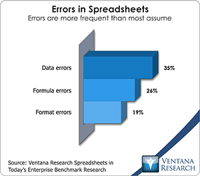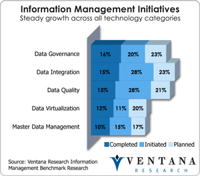Banking giant JP Morgan raised eyebrows in 2012 when it revealed that it had lost a substantial amount of money because of poorly conceived trades it had made for its own account. The losses raised questions about the adequacy of its internal controls, and broader questions about the need for regulations to reduce systemic risk to the banking system. At the heart of the matter were the transactions made by “the London Whale,” the name given to a JP Morgan’s trading operation in the City by its...
Read More
Topics:
Sales,
GRC,
Office of Finance,
Operational Performance Management (OPM),
error,
Business Analytics,
Business Collaboration,
Business Intelligence,
Business Performance Management (BPM),
Data,
Financial Performance Management (FPM),
Information Management (IM),
Sales Performance Management (SPM),
controls
This is the third in a series of blog posts on what CEOs (and for that matter, all senior corporate executives) need to know about IT and its impact on running a business. The first covered the high-level issues. As I noted, it’s not necessary for a CEO to be able to write Java code or master the intricacies of an ERP or sales compensation application. However, CEOs must grasp the basics of IT just as they must understand basic corporate finance, the production process and – at least at a high...
Read More
Topics:
Planning,
Predictive Analytics,
Sales,
Customer,
Human Capital Management,
Office of Finance,
Operational Performance Management (OPM),
Budgeting,
close,
closing,
PRO,
Analytics,
Business Analytics,
Business Performance Management (BPM),
CFO,
Customer Performance Management (CPM),
Financial Performance Management (FPM),
Information Management (IM),
Sales Performance Management (SPM),
CEO,
FPM,
Profitability,
SPM
Quantrix recently unveiled Quantrix 5, an updated version of its financial modeling software designed to fill the gap between spreadsheets and business intelligence (BI) systems. Quantrix provides users with many of the capabilities of an enterprise system and addresses shortcomings of desktop spreadsheet software without requiring extensive training.
Read More
Topics:
Big Data,
Planning,
Sales,
FP&A,
Office of Finance,
Reporting,
Budgeting,
Quantrix,
Analytics,
Business Collaboration,
Cloud Computing,
Business Performance Management (BPM),
Information Management (IM),
Sales Performance Management (SPM),
Supply Chain Performance Management (SCPM),
Workforce Performance Management (WPM),
FPM
I recently started a series of blog posts on what CEOs (and for that matter, all senior corporate executives) need to know about IT. The first covered the high-level issues. As I noted there, it’s not necessary for a CEO of a company to be able to write Java code or master the intricacies of an ERP or sales compensation application. However, CEOs must grasp the basics of IT just as they must understand basic corporate finance, the production process and – at least at a high level – the...
Read More
Topics:
Big Data,
Mobile,
SaaS,
Social Media,
Customer,
ERP,
Operational Performance Management (OPM),
Business Analytics,
Business Collaboration,
Cloud Computing,
Complex Event Processing,
In-memory,
Business Performance Management (BPM),
CFO,
Customer Performance Management (CPM),
Financial Performance Management (FPM),
Information Management (IM),
Sales Performance Management (SPM),
Supply Chain Performance Management (SCPM),
Workforce Performance Management (WPM),
CEO,
PaaS
The idea of devising and using maturity assessments to improve business performance has been a staple of management, functional and strategic consultants for decades. It’s based on two unassailable principles. One is the general assertion that companies differ in their ability to do anything along a range from nonexistent to advanced. The second is that at any time it’s possible for a knowledgeable individual to construct a scale of competence for some business function from least to most...
Read More
Topics:
Performance Management,
Social Media,
Customer Experience,
Governance,
Operational Performance Management (OPM),
Business Analytics,
Business Collaboration,
Business Intelligence,
Cloud Computing,
Governance, Risk & Compliance (GRC),
Operational Intelligence,
Business Performance Management (BPM),
Customer Performance Management (CPM),
Financial Performance Management (FPM),
Information Applications (IA),
Information Management (IM),
IT Performance Management (ITPM),
Sales Performance Management (SPM),
Supply Chain Performance Management (SCPM),
Workforce Performance Management (WPM),
benchmark,
FPM
One of the community groups to which I donate my time is an organization that puts on a Concours d’Élegance – a vintage car show. Such Concours date back to seventeenth-century France, when wealthy aristocrats gathered to see who had the best carriages and most beaudacious horses. Our Concours serves as the centerpiece to a broader mission of raising money for several charities. There a many such events in the United States and elsewhere, but this one, which has been held every year since 1956,...
Read More
Topics:
Big Data,
GRC,
Operational Performance Management (OPM),
Business Analytics,
Business Intelligence,
CIO,
Operational Intelligence,
Business Performance Management (BPM),
CFO,
finance,
Financial Performance Management (FPM),
Information Management (IM),
IT Performance Management (ITPM),
Talent Management,
FPM
Our research consistently finds that defects in data are the root cause of a wide range of problems encountered by modern corporations. The magnitude of the problem correlates with the size of the company: Big companies have bigger headaches than midsize ones. Data issues diminish productivity in every part of a business as people struggle to correct errors or find workarounds. Issues with data are a man-made phenomenon, yet companies seem to treat bad data as some sort of force of nature like...
Read More
Topics:
Big Data,
Predictive Analytics,
GRC,
Operational Performance Management (OPM),
Business Analytics,
Business Intelligence,
CIO,
Operational Intelligence,
Business Performance Management (BPM),
CFO,
Customer Performance Management (CPM),
finance,
Financial Performance Management (FPM),
Information Management (IM),
IT Performance Management (ITPM),
Sales Performance Management (SPM),
Supply Chain Performance Management (SCPM),
Workforce Performance Management (WPM),
FPM
For several years the U.S. Securities and Exchange Commission (SEC) has mandated that filers apply eXtensible Business Reporting Language (XBRL) tags to their financial statements. XBRL was developed to make it easier for investors to use a company’s financial information. Now XBRL US has kicked off its second annual XBRL Challenge, a contest designed to encourage development of open source analytical tools that can use XBRL-formatted corporate financial data from the SEC’s EDGAR database....
Read More
Topics:
Office of Finance,
Reporting,
closing,
XBRL,
Analytics,
Business Analytics,
Business Performance Management (BPM),
finance,
Financial Performance Management (FPM),
Information Management (IM),
Financial Performance Management,
SEC
Planning portfolio risk follows the same basic tenets as other sorts of business planning. It must be done in the context of a time dimension. In business, short-term plans are developed with a lot of givens or constraints. For example, capacities are fixed, because it’s impossible to wave a magic wand and bring a new factory on line, stuff more machine tools into already jammed facilities or source more raw materials in a capacity-limited supply chain. Short-term plans also incorporate...
Read More
Topics:
GRC,
Office of Finance,
Operational Performance Management (OPM),
Analytics,
Business Analytics,
Governance, Risk & Compliance (GRC),
Business Performance Management (BPM),
Business Planning,
Financial Performance Management (FPM),
Information Management (IM),
Risk,
Sales Performance Management (SPM)
Risk has always been an integral part of business, but our recent Governance, Risk and Compliance (GRC) benchmark research shows that companies deal with risk with varying degrees of effectiveness – especially operational risk. A majority of companies lag in their overall GRC maturity, as I covered in a recent blog post. Operational risk management should be of greater interest to executives today because they can have greater control of it than before. The expansion of IT systems to automate...
Read More
Topics:
Big Data,
Performance Management,
Predictive Analytics,
Customer Experience,
Governance,
GRC,
Operational Performance Management (OPM),
Management,
Analytics,
Business Analytics,
Business Collaboration,
Business Intelligence,
Governance, Risk & Compliance (GRC),
Operational Intelligence,
Business Performance Management (BPM),
compliance,
Customer Performance Management (CPM),
finance,
Financial Performance Management (FPM),
Information Applications (IA),
Information Management (IM),
IT Performance Management (ITPM),
Risk,
Sales Performance Management (SPM),
Supply Chain Performance Management (SCPM),
Workforce Performance Management (WPM),
financial risk management












